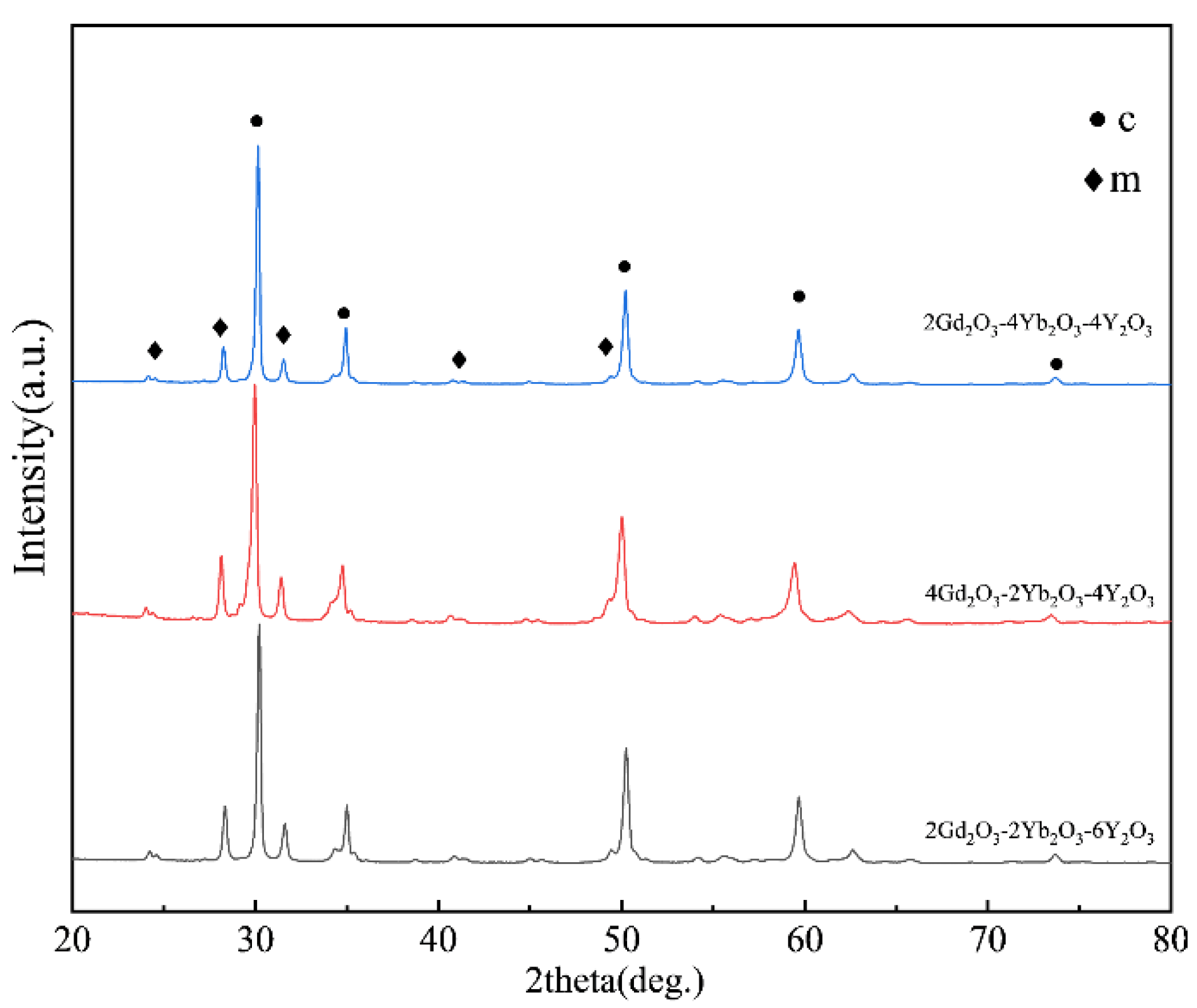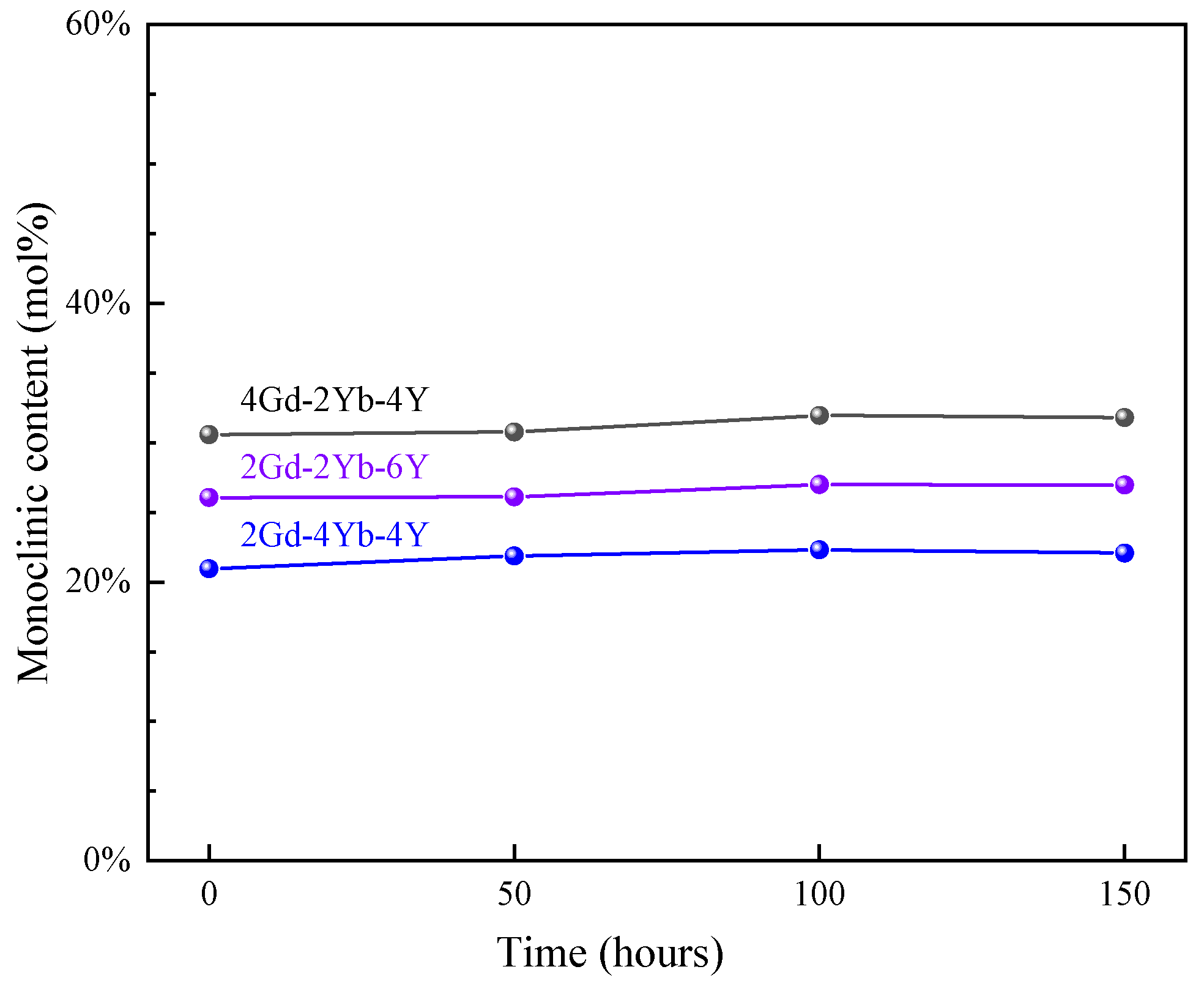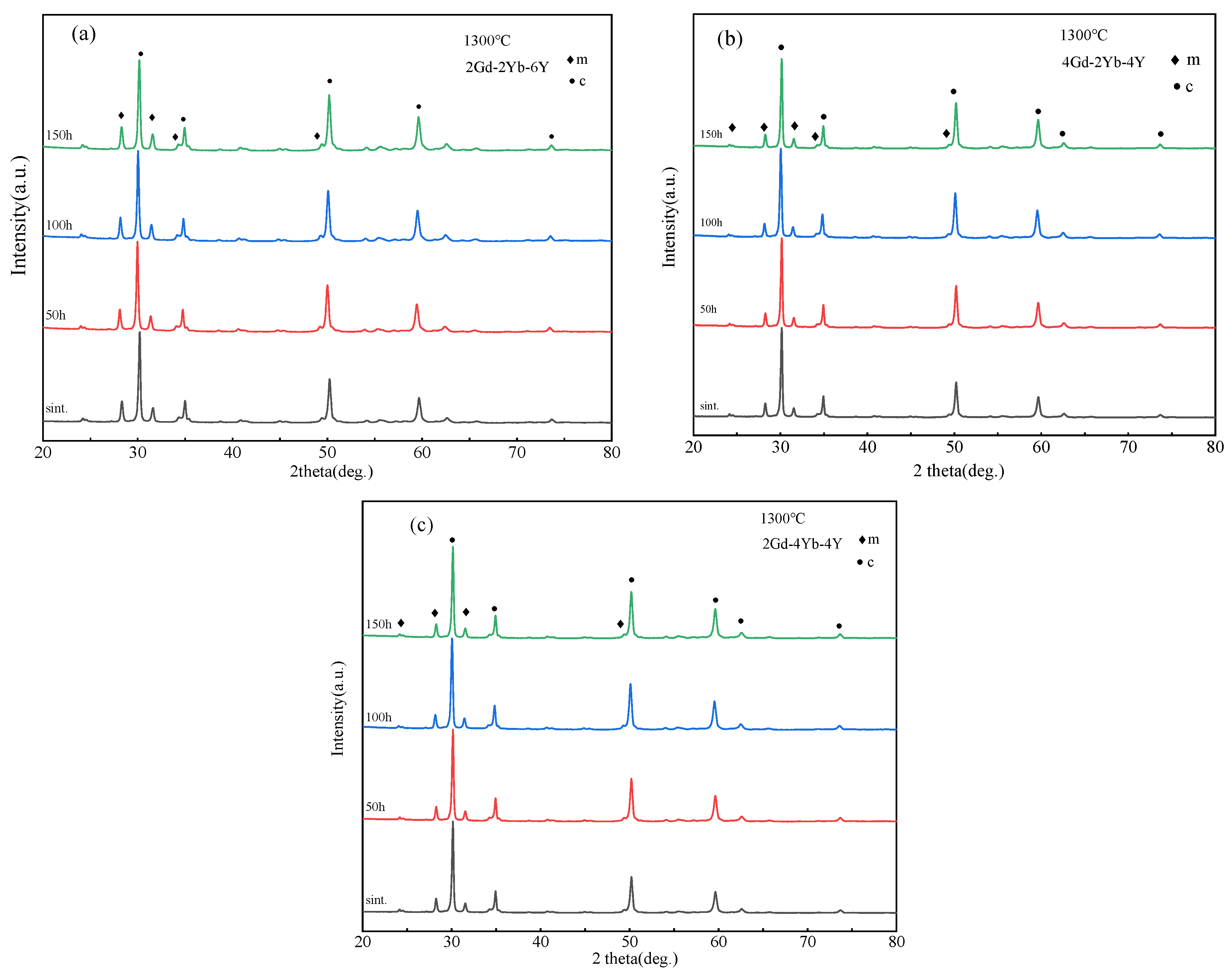Phase Composition and Stability, Sintering and Thermal Conductivity of Gd2O3 and Yb2O3 Co-Doped YSZ
Abstract
1. Introduction
2. Experimental Procedure
3. Results and Discussion
4. Conclusions
- Analysis of the phase content analysis of the synthesized powders revealed that the content of m phase gradually decreased for the powders 4Gd-2Yb-4Y, 2Gd-2Yb-6Y, and 2Gd-4Yb-4Y. This suggests that Yb2O3 effectively suppresses the formation of the m phase and is an excellent stabilizer for ZrO2. A subsequent heat treatment test at 1300 °C, conducted for 150 h, showed that m phase remained almost unchanged, indicating that it can significantly improve the toughness of a given material.
- No sintering was observed in any of the powders, suggesting that the addition of Gd2O3 and Yb2O3 improves the sintering resistance of YSZ materials.
- Co-doping Gd2O3 and Yb2O3 can effectively reduce the thermal conductivity of YSZ. The co-doping increases the discrepancy between the radius and atomic mass of RE3+ and Zr4+ ions, which increases the phonon scattering and reduces the thermal conductivity of the material, resulting in increased phonon scattering. The experimental results indicate the Gd2O3 is more effective at decreasing thermal conductivity than co-doped ZrO2.
Author Contributions
Funding
Institutional Review Board Statement
Informed Consent Statement
Data Availability Statement
Conflicts of Interest
References
- Padture, N.P. Advanced structural ceramics in aerospace propulsion. Nat. Mater. 2016, 15, 804–809. [Google Scholar] [CrossRef] [PubMed]
- Clarke, D.R.; Levi, C.G. Materials Design for the Next Generation Thermal Barrier Coatings. Annu. Rev. Mater. Res. 2003, 33, 383–417. [Google Scholar] [CrossRef]
- Clarke, D.R.; Oechsner, M.; Padture, N.P. Thermal-barrier coatings for more efficient gas-turbine engines. MRS Bull. 2012, 37, 891–898. [Google Scholar] [CrossRef]
- Nomura, M.; Kage, Y.; Müller, D. Electrical and thermal properties of polycrystalline Si thin films with phononic crystal nanopatterning for thermoelectric applications. Appl. Phys. Lett. 2015, 106, 223106. [Google Scholar] [CrossRef]
- Yanagisawa, R.; Tsujii, N.; Mori, T. Nanostructured planar-type uni-leg Si thermoelectric generators. Appl. Phys. Express 2020, 13, 095001. [Google Scholar] [CrossRef]
- Clarke, D.R.; Phillpot, S.R. Thermal barrier coating materials. Mater. Today 2005, 8, 22–29. [Google Scholar] [CrossRef]
- Vassen, R.; Cao, X.Q.; Tietz, F. Zirconates as new materials for thermal barrier coatings. J. Am. Ceram. Soc. 2000, 83, 2023–2028. [Google Scholar] [CrossRef]
- Sun, C.; Hui, R.; Roller, J. Cathode materials for solid oxide fuel cells: A review. J. Solid State Electrochem. 2010, 14, 1125–1144. [Google Scholar] [CrossRef]
- Kakuda, T.R.; Limarga, A.M. Evolution of thermal properties of EB-PVD 7YSZ thermal barrier coatings with thermal cycling. Acta Mater. 2009, 57, 2583–2591. [Google Scholar] [CrossRef]
- Evans, A.G.; Clarke, D.R. The influence of oxides on the performance of advanced gas turbines. J. Eur. Ceram. Soc. 2008, 28, 1405–1419. [Google Scholar] [CrossRef]
- Darolia, R. Thermal barrier coatings technology: Critical review, progress update, remaining challenges and prospects. Int. Mater. Rev. 2013, 58, 315–348. [Google Scholar] [CrossRef]
- Wang, Y.; Zhou, C. Hot corrosion behavior of nanostructured Gd2O3 doped YSZ thermal barrier coating in presence of Na2SO4 + V2O5 molten salts. Prog. Nat. Sci. Mater. Int. 2017, 27, 507–513. [Google Scholar] [CrossRef]
- Wang, C.; Zinkevich, M.; Aldinger, F. Phase diagrams and thermodynamics of rare-earth-doped zirconia ceramics. Pure Appl. Chem. 2007, 79, 1731–1753. [Google Scholar] [CrossRef]
- Lu, X.; Xu, P.; Wang, H. Cooling potential and applications prospects of passive radiative cooling in buildings: The current state-of-the-art. Renew. Sustain. Energy Rev. 2016, 65, 1079–1097. [Google Scholar] [CrossRef]
- Vasanthavel, S.; Kannan, S. Structural investigations on the tetragonal to cubic phase transformations in zirconia induced by progressive yttrium additions. J. Phys. Chem. Solids 2018, 112, 100–105. [Google Scholar] [CrossRef]
- Hurwitz, F.I.; Rogers, R.B.; Guo, H. Phase development and pore stability of yttria- and ytterbia-stabilized zirconia aerogels. J. Am. Ceram. Soc. 2020, 103, 6700–6711. [Google Scholar] [CrossRef]
- Ochrombel, R.; Schneider, J.; Hildmann, B. Thermal expansion of EB-PVD yttria stabilized zirconia. J. Eur. Ceram. Soc. 2010, 30, 2491–2496. [Google Scholar] [CrossRef]
- Naraparaju, R.; Hüttermann, M.; Schulz, U. Tailoring the EB-PVD columnar microstructure to mitigate the infiltration of CMAS in 7YSZ thermal barrier coatings. J. Eur. Ceram. Soc. 2017, 37, 261–270. [Google Scholar] [CrossRef]
- Lashmi, P.G.; Ananthapadmanabhan, P.V.; Unnikrishnan, G. Present status and future prospects of plasma sprayed multilayered thermal barrier coating systems. J. Eur. Ceram. Soc. 2020, 40, 2731–2745. [Google Scholar] [CrossRef]
- Ponnuchamy, M.B.; Gandhi, A.S. Phase and fracture toughness evolution during isothermal annealing of spark plasma sintered zirconia co-doped with Yb, Gd and Nd oxides. J. Eur. Ceram. Soc. 2015, 35, 1879–1887. [Google Scholar] [CrossRef]
- Lima, R.S. Perspectives on Thermal Gradients in Porous ZrO2-7~8 wt.% Y2O3 (YSZ) Thermal Barrier Coatings (TBCs) Manufactured by Air Plasma Spray (APS). Coatings 2020, 10, 812. [Google Scholar] [CrossRef]
- Clarke, D.R.; Levi, C.G. Enhanced zirconia thermal barrier coating systems. Proc. Inst. Mech. Eng. Part A J. Power Energy 2006, 220, 85–92. [Google Scholar] [CrossRef]
- Ren, X.; Pan, W. Mechanical properties of high-temperature-degraded yttria-stabilized zirconia. Acta Mater. 2014, 69, 397–406. [Google Scholar] [CrossRef]
- Fu, Z.; Wu, N.; Long, H. Fabrication of Highly Transparent Y2O3 Ceramics via Colloidal Processing Using ZrO2-Coated Y2O3 Nanoparticles. Coatings 2022, 12, 1077. [Google Scholar] [CrossRef]
- Guo, L.; Zhang, C.; Xu, L. Effects of TiO2 doping on the defect chemistry and thermo-physical properties of Yb2O3 stabilized ZrO2. J. Eur. Ceram. Soc. 2017, 37, 4163–4169. [Google Scholar] [CrossRef]
- Cairney, J.M.; Rebollo, N.R.; Rühle, M. Phase stability of thermal barrier oxides: A comparative study of Y and Yb additions. Int. J. Mater. Res. 2007, 98, 1177–1187. [Google Scholar] [CrossRef]
- Rahaman, M.; Gross, J.; Dutton, R. Phase stability, sintering, and thermal conductivity of plasma-sprayed ZrO2–Gd2O3 compositions for potential thermal barrier coating applications. Acta Mater. 2006, 54, 1615–1621. [Google Scholar] [CrossRef]
- Boissonnet, G.; Chalk, C.; Nicholls, J.R. Phase stability and thermal insulation of YSZ and erbia-yttria co-doped zirconia EB-PVD thermal barrier coating systems. Surf. Coat. Technol. 2020, 389, 125566. [Google Scholar] [CrossRef]
- Jones, R.L.; Mess, D. Improved tetragonal phase stability at 1400 °C with scandia, yttria-stabilized zirconia. Surf. Coat. Technol. 1996, 86, 94–101. [Google Scholar] [CrossRef]
- Leoni, M.; Jones, R.L.; Scardi, P. Phase stability of scandia–yttria-stabilized zirconia TBCs. Surf. Coat. Technol. 1998, 108, 107–113. [Google Scholar] [CrossRef]
- Fan, W.; Wang, Y.; Liu, Y. Mechanical Properties Durability of Sc2O3-Y2O3 Co-Stabilized ZrO2 Thermal Barrier Materials for High Temperature Application. Coatings 2022, 12, 155. [Google Scholar] [CrossRef]
- Yan, Z.; Peng, H.; Yuan, K. Optimization of Yb2O3-Gd2O3-Y2O3 Co-Doped ZrO2 Agglomerated and Calcined Powders for Air Plasma Spraying. Coatings 2021, 11, 373. [Google Scholar] [CrossRef]
- Sun, L. Influence of partial substitution of Sc2O3 with Gd2O3 on the phase stability and thermal conductivity of Sc2O3-doped ZrO2. Ceram. Int. 2013, 39, 3447–3451. [Google Scholar] [CrossRef]
- Guo, L.; Li, M.; Ye, F. Phase stability and thermal conductivity of RE2O3 (RE = La, Nd, Gd, Yb) and Yb2O3 co-doped Y2O3 stabilized ZrO2 ceramics. Ceram. Int. 2016, 42, 7360–7365. [Google Scholar] [CrossRef]
- Miller, R.A. Phase stability in plasma sprayed partially stabilized zirconia-yttria. Am. Ceram. Soc. 1981, 3, 241–253. [Google Scholar]
- Kubaschewski, O. Materials Thermochemistry, 6th ed.; Pergamon Press: Oxford, UK, 1993; pp. 254–326. [Google Scholar]
- Wu, J.; Wei, X.Z.; Padture, N.P. Low-thermal-conductivity rare-earth zirconates for potential thermal-barrier-coating applications. J. Am. Ceram. Soc. 2002, 85, 3031–3035. [Google Scholar] [CrossRef]
- Zacate, M.O.; Minervini, L. Defect cluster formation in M2O3-doped cubic ZrO2. Solid State Ion. 2000, 128, 243–254. [Google Scholar] [CrossRef]
- Xue, M.; Liu, S.; Wang, X. High fracture toughness of 3Y-TZP ceramic over a wide sintering range. Mater. Chem. Phys. 2020, 244, 122693. [Google Scholar] [CrossRef]
- Zhang, Y.; Guo, L.; Zhao, X. Toughening effect of Yb2O3 stabilized ZrO2 doped in Gd2Zr2O7 ceramic for thermal barrier coatings. Mater. Sci. Eng. A 2015, 648, 385–391. [Google Scholar] [CrossRef]
- Tian, Z.; Lin, C.; Zheng, L. Defect-mediated multiple-enhancement of phonon scattering and decrement of thermal conductivity in (YxYb1-x)2SiO5 solid solution. Acta Mater. 2018, 144, 292–304. [Google Scholar] [CrossRef]
- Ishibe, T.; Tomeda, A.; Komatsubara, Y. Carrier and phonon transport control by domain engineering for high-performance transparent thin film thermoelectric generator. Appl. Phys. Lett. 2021, 118, 151601. [Google Scholar] [CrossRef]
- Berman, R. Thermal Conduction in Solid; Clarendon Press: Oxford, UK, 1976. [Google Scholar]






| Gd2O3 mol% | Yb2O3 mol% | Y2O3 mol% | a = b = c (Å) |
|---|---|---|---|
| 10 | 5.138 | ||
| 2 | 2 | 6 | 5.133 |
| 4 | 2 | 4 | 5.151 |
| 2 | 4 | 4 | 5.131 |
Disclaimer/Publisher’s Note: The statements, opinions and data contained in all publications are solely those of the individual author(s) and contributor(s) and not of MDPI and/or the editor(s). MDPI and/or the editor(s) disclaim responsibility for any injury to people or property resulting from any ideas, methods, instructions or products referred to in the content. |
© 2022 by the authors. Licensee MDPI, Basel, Switzerland. This article is an open access article distributed under the terms and conditions of the Creative Commons Attribution (CC BY) license (https://creativecommons.org/licenses/by/4.0/).
Share and Cite
Tian, H.; Wei, L.; He, L. Phase Composition and Stability, Sintering and Thermal Conductivity of Gd2O3 and Yb2O3 Co-Doped YSZ. Coatings 2023, 13, 53. https://doi.org/10.3390/coatings13010053
Tian H, Wei L, He L. Phase Composition and Stability, Sintering and Thermal Conductivity of Gd2O3 and Yb2O3 Co-Doped YSZ. Coatings. 2023; 13(1):53. https://doi.org/10.3390/coatings13010053
Chicago/Turabian StyleTian, He, Liangliang Wei, and Limin He. 2023. "Phase Composition and Stability, Sintering and Thermal Conductivity of Gd2O3 and Yb2O3 Co-Doped YSZ" Coatings 13, no. 1: 53. https://doi.org/10.3390/coatings13010053
APA StyleTian, H., Wei, L., & He, L. (2023). Phase Composition and Stability, Sintering and Thermal Conductivity of Gd2O3 and Yb2O3 Co-Doped YSZ. Coatings, 13(1), 53. https://doi.org/10.3390/coatings13010053




